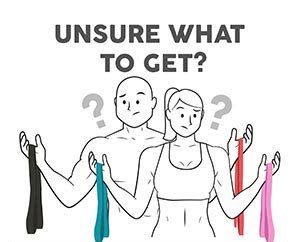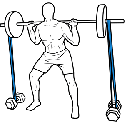Wondering how to do assisted pull-ups with bands? Let's set the scene. You're a bright-eyed, young traveler setting out on their first long trip away from home. You have a few things planned on this trip and some space and time to do whatever. You'll likely get most of your planned activities done, but will likely miss a few things here and there, and sometimes you'll stumble into something you didn't think of doing before you started that you use your extra time for.
This trip is the road to the first chin-up or pull-up for most people.
The organized few stick to their plans most of the time, have good plans set, and do what they can to accommodate any changes that might happen. Some forget their passport at home or lose their wallet at the airport or while they are away and have to delay, cancel or shorten their trip entirely. Others change their plans and go on a different journey to the one they started on. And some might never come home, forever traveling on an amazing new path they really enjoy.
I bring this up because getting your first chin up or pullup can be a big time and energy investment. Everyone wants to be the organizedtraveler, or travel for life, getting pull-ups and going beyond, but it isn't always worth that much to everyone AND THAT IS OK. Everybody is different.
Now that we have this out of the way and you are still here reading, let's get technical.
A chin-up is a bodyweight exercise that involves all of your body to be as efficient as it can be but is dominated by the need for good grip/forearm, biceps, shoulder, scapular and lat strength. Core strength is helpful, but not essential.
If you are chasing your first chin up I recommend a diet of the following, with the usual horizontal pressing, vertical pressing exercises, and legwork sprinkled between as necessary.
For grip strength
Passive and Active Hanging (sets of 40 seconds and more is a reasonable but not necessary benchmark if you are interested in length). This is a good warm-up provided the hang isn't maximum length.
Fat Grip Variations of the deadlift, inverted rows and bent over rows.
Biceps Strength
Note: I would usually do these AFTER main lat exercises.
Biceps Barbell Curl. Yes, this is for gym rats, but the gold standard for a reason. I recommend finishing each curl at forehead height to encourage more biceps work from its attachment at the shoulder.
Extended Biceps Band Curl. This exercise is a great one because it can teach scapular retraction for those that struggle, as well as get in some much-needed shoulder extension after all those pulldowns and assisted chin ups. The band also gives you a little extra grip work for free.
Spider/Incline Curl. This exercise limits the momentum you can put into your curls and puts you in a starting position where you are over the dumbbells, which encourages more prominent shoulder flexion within the movement.
Shoulder/Scapula Strength
Face Pulls. This is good for developing the traps and rhomboids as well as the rear delts. Encourages some understanding of scapular retraction which comes in handy when working chin up and pull up variations. These are what initiate a good pull or chin up, and often what lacks most in beginners, especially those working desk jobs.
Rear Delt Fly. This one is good for drilling scapular retraction as well as growing the strength of the rear delts.
Lat Strength
Band Assisted Pull Ups. Use these sparingly as the band helps you most at the bottom (and stops you in ways from getting stronger where you need it most).
Eccentric Chin Ups. Good to use in small numbers. Very important to keep shoulders away from ears throughout the movement. Not for absolute beginners.
Inverted Row. Great for volume work as they work the lats very directly and are very scalable and measurable.
Straight Arm Pulldowns. Good accessory work but not made to be the meat and cheese,
In terms of programming this mixture of exercises effectively, I would be doing 3-5 sets and 3-15 repetitions of most of these exercises 2-4 times per week with an equated pushing volume attached to my workout programme, starting with the biggest muscles (lats) and working from big to small (lats, shoulders/scapula, biceps, forearms/grip). If you want to train more frequently, ensure the sets and repetitions are lower, and vice versa if you are getting in less.
An example chin up 'day' has been provided below to show you exactly what that could look like (this hypothetical person is only doing 1 or 2 sessions a week):
Eccentric Chin Up: 4 sets of 3 repetitions
Band Assisted Pull Up: 3 sets of 8-12 repetitions
Face Pulls: 3 sets of 15 repetitions
Fat Grip Bicep Curl: 3 sets of 7-9 repetitions
Simple, but effective. To ensure you are improving, make sure you increase the number of repetitions you do from week to week and/or the weight/resistance of the exercise. From there, you would do a pushing day next to ensure you aren’t unevenly loading your muscles consistently. As you can see a few of these need a band, and others need a chin up bar. You can find them here if you are behind the 8 ball as it stands: https://www.rubberbanditz.com/info-center/pull-up-bands/
What this all builds to is having all the pre-requisite strength for your first pull up or chin up. How exciting! As far as the perfect chin-up goes, it should begin by going from our passive to our active hang as we see in the video above. The way we do this is by opening our chest and by bringing our collarbones up towards the bar. This, done correctly, activates the muscles of the middle and upper back and pulls the shoulder blades towards one another (retracts them). This provides a stable base to pull from and reduces our risk of shoulder injuries when doing chin ups and pull ups.
After retracting the shoulder blades, we pull our elbows towards the ground and our chest towards the bar, ensuring that we keep our core braced and our ribs aren’t flaring. The gold standard is to be able to get our chest to the bar at the top of each rep. Once we hit the top position, we reverse the movement, keeping our shoulder blades retracted until our elbows are straight and then relaxing them to enter the passive hang we started with.
Things we should look out for:
-
Rocking and kipping: This is fine in the context of CrossFit where the intention is to do more work in less time, but if we aren’t breaking records it is safer to be strict and use the proper form that is easily controlled. In short: please don’t kip. If you do and you aren’t meaning to: look at scapular strength first.
-
Grip Width: Grip width will vary based on anatomical structures, but generally speaking having a shoulder-width (relatively narrow grip) is recommended because from what I have seen, people struggle to retract their shoulder blades. In a wider grip, retraction is harder to achieve and this ends up in us using rotators like the teres muscles instead which can lead to issues if not looked after.
-
Shoulders near ears: People struggle to progress with their chin ups, generally speaking. A lot of this comes from poor form and a lack of development in targeted muscles. One main contributor to poor form is not retracting the scapula and instead using shoulder rotation to get the job done. This is where the signature “shrug” look comes from in pulldowns and chin-ups- a lack of retraction. The ears end up close to the shoulders and this is a sign we need to retract harder.
If you have a couple pull ups or chin ups, the programming doesn’t drastically change, but the exercises can. You can still use the ones mentioned earlier with a higher resistance or rep range to improve provided repetitions and resistance is progressively added with time, however, it is important to not stray too far from what you want to improve. This means doing chin-ups and pullups themselves should form a more regular part of your training and adding weight or repetitions over time to these should be your primary focus.
Additional exercises worth considering if you have a few chin-ups, but are greedy for more:
Tuck Front Lever Pulls. Scapula, lat and shoulder strength. A "bodyweight" straight arm pulldown for those lacking equipment.
Mixed Grip Chin Ups. An alternative to the standard that targets one arm more so than the other. Good for variety's sake.
Weighted Chin Ups. A simple and easily measurable way to improve on your chin ups. Adding weight ensures a normal chin-up slowly represents less relative to your one rep maximum.
Band Resisted Chin Ups. Good in lieu of a weighted alternative. An added bonus to these is they get harder the closer you get to the bar and will help you get that last little bit of range at the top.
Happy pull-ups! Check out our assisted pullup band selection to help fast track your reps.



